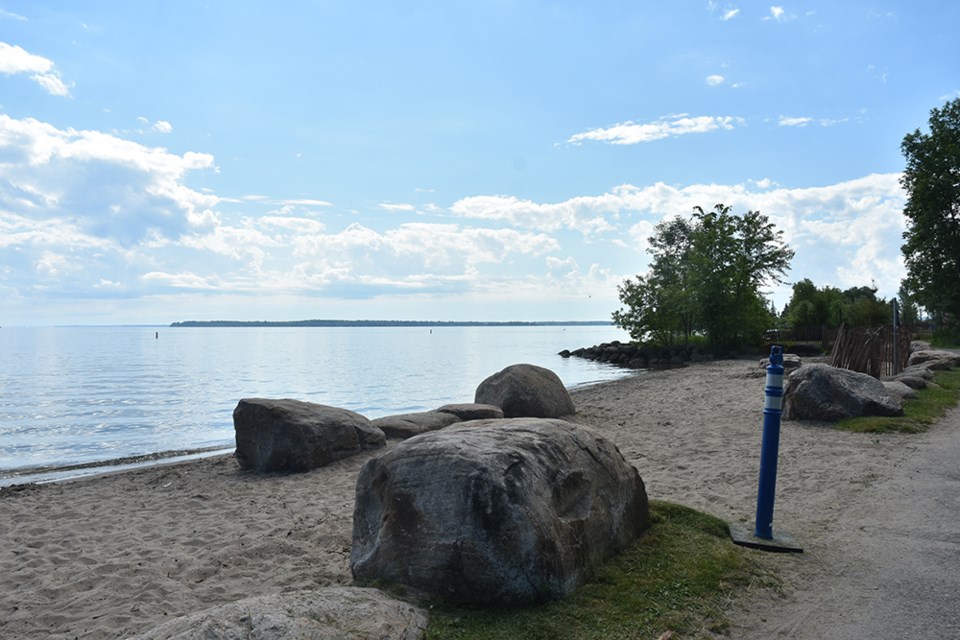The Simcoe Muskoka District Health Unit (SMDHU) does more than deal with COVID-19 and its spread.
The Health Unit is also tasked with a wide range of health-related activities, training and responsibilities - including water quality testing of area beaches, throughout Simcoe County and Muskoka Region.
From June to the Labour Day weekend, water samples are taken weekly and analyzed at over 50 beaches, said Christi Wieder, program manager with the Environmental Health department at the SMDHU - measuring the levels of the bacteria E.coli in the water.
“We hire two summer students” to carry out the sampling, Wieder said, in addition to working with municipal staff in some areas.
If E.coli levels are elevated, the SMDHU will resample – and if the high levels are confirmed, will issue a Swimming Advisory, posting signs that warn against swimming due to the risk of “minor skin, eye, ear, nose or throat infections or stomach illness.”
Those who enter the water despite the advisory are told to avoid submerging their head, or ingesting the water.
If levels are high enough, as a result of a sewage spill, or if there is some other danger, a beach might be closed – but that’s a rare event.
E.coli levels – associated with fecal matter – are often elevated after heavy rainfall or high wave action, when there are large numbers of swimmers in shallow waters, or when large numbers of waterfowl, such as Canada geese, move into an area.
“You don’t want to be feeding the ducks and the geese,” Wieder said. “It’s fun, but you’re creating a habitat where geese and gulls want to stay, and their excrement is very high in E. coli.”
High levels of bacteria are also often association with storms and high rainfall events, “washing everything from the road and the land” into the water, she noted, citing the example of Tay Twp.
As of last week, the health unit had tested beaches in Barrie, Bracebridge, Clearview, Collingwood, Georgian Bay, Gravenhurst, Huntsville, Innisfil, Lake of Bays, Midland, Muskoka Lakes, Orillia, Oro-Medonte, Penetanguishene, Severn, Tay and Tiny.
Innisfil’s beaches – both at Innisfil Beach Park North and South, and Leonard’s Beach – were given the green light, but two beaches in Tay (Mackenzie Park Beach and Waubaushene Beach), were posted with a Swim Advisory.
“Tay has had a couple of adverse results,” Wieder said. “It seems that is weather-related, after a couple of heavy rainfalls.”
Staff also watch for other hazards in the water, from floating debris and abandoned boats, to blue-green algal blooms, which can release toxins dangerous to both animals and people.
While only a couple of types of algae pose a hazard, the protocol is to notify the municipality and the MNR (Ministry of Natural Resources) for sampling and investigation, and to advise the public to avoid the area.
An algal bloom at Little Lake Park in Midland is currently under investigation, Wieder noted.
Anyone thinking of using a beach in Simcoe County or Muskoka is advised to check the SMDHU website, for the latest information on water quality.
“It’s user friendly. It’s really mobile friendly, as well,” said Wieder, suggesting that if beach-goers find a destination is too crowded, during these COVID-19 times, they can also use the site to find the nearest alternative beach that is safe to use.
So far this summer, Innisfil’s beaches have had no problems, but the situation changes day to day. Wieder’s team will be back for another round of testing on Tuesday morning, “bright and early.”
To visit the SMDHU website for the latest information on the beaches and advisories, click here.



